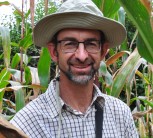Researchers and postgraduate students from the Forestry and Agricultural Biotechnology Institute (FABI) and the Genomics Research Institute (GRI) at the University of Pretoria contributed to eight articles in a special issue of the journal, New Phytologist. These articles cover diverse topics, such as genome diversity, comparative genomics, carbon allocation, protein evolution, floral development and woody biomass production in Eucalyptus trees.
New Phytologist published a special online issue, celebrating the completion of the Eucalyptus genome, the results of which were published in the prestigious journal, Nature, in June 2014. The special issue of New Phytologist (June 2015) contains genome companion papers, which further unfold into the unique biology of Eucalyptus trees, gained from the analysis of the genome.
Prof Zander Myburg, Prof Dave Berger, Dr Eshchar Mizrachi, Dr Steven Hussey from FABI and GRI and their postgraduate students contributed to the eight articles (listed below). This set of papers represents a significant advance in the understanding of the biology of the most widely planted hardwood fibre crop in the world. Together with the completed genome Populus, this genome resource will serve as a model and reference for the study of fast-growing woody plants that are used as renewable feed stocks for a growing number of bio-based products, such as timber, pulp, paper, cellulose, textiles, pharmaceuticals and bioenergy.
Strauss SH, Myburg AA. (2015) Plant scientists celebrate new woody plant genome. New Phytologist 206(4):1185-1187. 10.1111/nph.13053
Carocha V, Soler M, Hefer CA, Cassan-Wang H, Fevereiro P, Myburg AA, Paiva JAP, Grima-Pettenati J. (2015) Genome-wide analysis of the lignin toolbox of Eucalyptus grandis. New Phytologist 206(4):1297-1313. 10.1111/nph.13313
Kersting AR, Mizrachi E, Bornberg-Bauer E, Myburg AA. (2014) Protein domain evolution is associated with reproductive diversification and adaptive radiation in the genus Eucalyptus. New Phytologist 204(6):1328-1336. 10.1111/nph.13211
Hussey SG, Saïdi MN, Hefer C, Myburg AA, Grima-Pettenati J. (2014) Structural, evolutionary and functional analysis of the NAC domain protein family in Eucalyptus. New Phytologist 206(4):1337-1350. 10.1111/nph.13139
Mizrachi E, Maloney VJ, Silberbauer J, Hefer CA, Berger DK, Mansfield SD, Myburg AA. (2014) Investigating the molecular underpinnings underlying morphology and changes in carbon partitioning during tension wood formation in Eucalyptus. New Phytologist 204(6):1351-1363. 10.1111/nph.13152
Soler M, Myburg AA, Paiva JAP, Hefer CA, Savelli B, Clemente HS, Cassan-Wang H, Carocha V, Camargo ELO, Grima-Pettenati J. (2015) The Eucalyptus grandis R2R3-MYB transcription factor family: evidence for woody growth-related evolution and function. New Phytologist 206(4):1364–1377. 10.1111/nph.13039
Hudson CJ, Freeman JS, Myburg AA, Potts BM, Vaillancourt RE. (2015) Genomic patterns of species diversity and divergence in Eucalyptus. New Phytologist 204(6):1378-1390. 10.1111/nph.13316
Hefer CA, Mizrachi E, Myburg AA, Douglas CJ, Mansfield SD. (2015) Comparative interrogation of the developing xylem transcriptomes of two wood‐forming species: Populus trichocarpa and Eucalyptus grandis. New Phytologist 204(6):1391-1405. 10.1111/nph.13277
Prof Zander Myburg, Prof Dave Berger, Dr Eshchar Mizrachi, Dr Steven Hussey
May 13, 2015


Dr Steven Hussey completed his undergraduate studies at the University of Pretoria (UP). He holds an MSc and a PhD, and has been doing research at UP for the past eight years since completing his doctoral studies.
“Doing research at UP has allowed me to work with some of the top plant biologists in the country,” Dr Hussey says. “I grew up within the UP environment, so it was natural for it to become my academic home. Not only does UP have a world-leading forest biotechnology institute, FABI, but it also has longstanding collaborations with some of the top forestry industry partners in the country.”
Dr Hussey’s research is focused on the genetic control of wood development and its improvement. Wood and wood-based products are renewable, and are essential components of daily life; this includes everything from timber to paper, textiles and foodstuff. Researchers are regularly finding novel applications for products derived from woody biomass.
“By understanding how wood is formed – that is, the biological pathways involved in its development – we can potentially manipulate and improve both wood property traits and the yield we obtain per unit area of plantation,” he explains.
A major milestone for Dr Hussey was receiving the US Department of Energy Joint Genome Research (DOE-JGI) grant to synthesise the largest panel of synthetic gene constructs for eucalyptus in the world (published 2019).
“Linked to that, I was successful in getting a National Research Foundation Competitive Support for Rated Researchers grant in 2021, which valorises the DOE-JGI research by using these gene constructs to screen thousands of interactions between potential genes that might control wood formation. This is an unprecedented undertaking in forestry research.”
Within his academic discipline, Dr Hussey is a group leader on the transcriptional regulation and bioengineering of wood formation, collaborating closely with other tree biotechnology researchers at FABI such as Professor Zander Myburg, Prof Sanushka Naidoo and Prof Eshchar Mizrachi.
“I work on the network of genes that control how wood develops in trees along a spatio-temporal gradient,” he explains. “Essentially, I study how certain genes turn on and off at the right time and the relationships between them to coordinate cellular development within trees. We are also testing whether manipulating certain genes can alter wood development. We do this by promoting or inhibiting the function of a particular gene of interest and observing what effects this has on tree growth, biomass and wood property traits.”
As for inspiration in his research effort, he credits his PhD advisors for their constant encouragement. “Their advice, mentorship and training helped me to launch my career and pursue my research focus.”
He also has a great number of academic mentors and role models.
“One particularly influential academic role model is Prof Jim Haseloff of the University of Cambridge, who is a world leader in plant synthetic biology but who also exercises incredible humility, pursues projects with a strong community engagement focus rather than an obsession with large numbers of high-impact publications, and who has reached out to developing countries to disseminate practical tools and knowledge to stimulate innovation. He embodies what I think is the perfect balance between academic excellence, impact and community benefit.”
Dr Hussey says he does not have one particular ambition regarding his work. “Science is never ‘done’ – the pleasure is in its execution and the dream is having the rare opportunity to contribute new knowledge to humanity.”
Why does his research matter? “Plants possess about 450 gigatons (about 80%) of organically bound carbon present in Earth’s biomass. Of this, nearly 70% is sequestered as woody biomass in trees and other woody shrubs. How is this biomass formed? How it is genetically controlled? How can we manipulate these processes and tailor woody biomass to different downstream applications? By trying to address these questions, my research potentially impacts the most abundant form of biomass on Earth.”
His advice to learners and undergraduate students is to be prepared to be adaptable. The next generation of researchers will require remarkable resilience in a changing world. “It isn’t always a neat linear trajectory. You might change jobs or roles – perhaps even fields of study – a number of times before settling into your dream job. Secondly, remember that buzzwords like ‘biotechnology’ or ‘synthetic biology’ are merely tools or approaches – they are not fields of study in themselves. Focus on building a strong foundation on the pure sciences and upskill yourself in critical future skills like programming.”
Dr Hussey says he loves nature and music. “I am (was!) an accomplished pianist, and I love bonsai, gardening and reefing (reef tank aquaculture).”

Professor Eshchar Mizrachi completed his undergraduate studies as well as his honours, master’s and PhD degrees at the University of Pretoria (UP). He has been employed at the University since 2006, was appointed as a senior lecturer in 2013 and as associate professor in 2019.
Prof Mizrachi says that UP is home to several world-class institutes and facilities that support his area of interest: genomics, bioinformatics and biotechnology. One of his main personal drivers in his career is empowering early-career researchers in Africa and around the world, and doing research that has an impact on society. UP, he adds, creates spaces and initiatives that foster transdisciplinary research in Africa.
Recently, his laboratory has led a multi-lab collaboration to sequence the genome of the king protea (Protea cynaroides), South Africa’s national flower and an iconic representative of the country’s biodiversity and the Cape Floral Kingdom. The genome opens up research opportunities to better understand the ecology, evolution and conservation of protea species and their relatives, and enables new horticulture research.
“My research focuses on sequencing the genomes of indigenous South African and African plant species and modelling complex biological processes, such as carbon allocation and partitioning in plant biomass formation and specialised roots for the acquisition of phosphorus and nitrogen in nutrient-poor soils,” Prof Mizrachi explains. He adds that this methodology can be applied broadly to answer questions about how novel pathways in plants are regulated by gene networks for the production of important chemical compounds.
“In the past decade or so, a convergence of technologies, computational capacity and a global drive for a more sustainable bioeconomy has highlighted the need to study and understand fundamental plant biology and evolution,” he says. Prof Mizrachi believes that his field of research contributes to the betterment of the world because the sequencing of plant genomes and the characterisation of the function of genes and gene networks that control plant traits such as growth, development and nutrient acquisition are critical for conservation efforts, biotechnology in agriculture and forestry, and for synthetic biology applications for novel products such as pharmaceuticals and nutraceuticals.
“I believe we have a moral responsibility in South Africa to study our indigenous plant biodiversity and connect our citizens to it,” he says. With 20 000 to 25 000 plant species, many of which originate in and/or occur exclusively in the country, South Africa is in the top five countries in the world for plant biodiversity. Despite this, the legacy of systemic inequalities is preventing knowledge about our rich biodiversity from reaching most of South Africa’s citizens, especially at a young age. We are engaging with stakeholders in the creative industries to find new ways to foster these connections.”
He has the following message for school learners or undergraduates: “Despite my lifelong love of nature and having researched plants for more than 15 years, it is important to note that I did not study biology in high school, and only really began studying plant biology after my master’s degree. Don’t ever think it’s too late to pursue something you are interested in or curious about.”
Prof Mizrachi hopes that his research contributes to answering fundamental questions about plant development and evolution, and leads to a broader interest from the public to engage with and value the natural world, particularly the amazing plant biodiversity that is around us.
 Story
Story
This edition is curated around the concept of One Health, in which the University of Pretoria plays a leading role globally, and is based on our research expertise in the various disciplines across healthcare for people, the environment and animals.
 Story
Story
Highly sophisticated water management techniques of ancient civilisations demonstrate the ingenuity of inhabitants who lived with limited water. It appears we need to look to the past to ensure a stable water supply in the future.
 Story
Story
A new study by researchers at the University of Pretoria (UP) and the University of Adelaide in Australia has revealed the real function of the giraffe’s long legs ¬– to reduce blood pressure.
Copyright © University of Pretoria 2025. All rights reserved.
Get Social With Us
Download the UP Mobile App